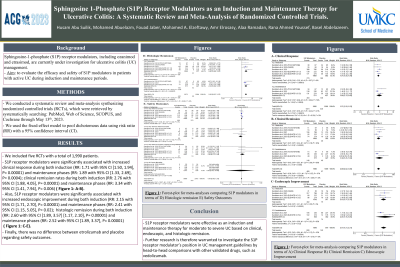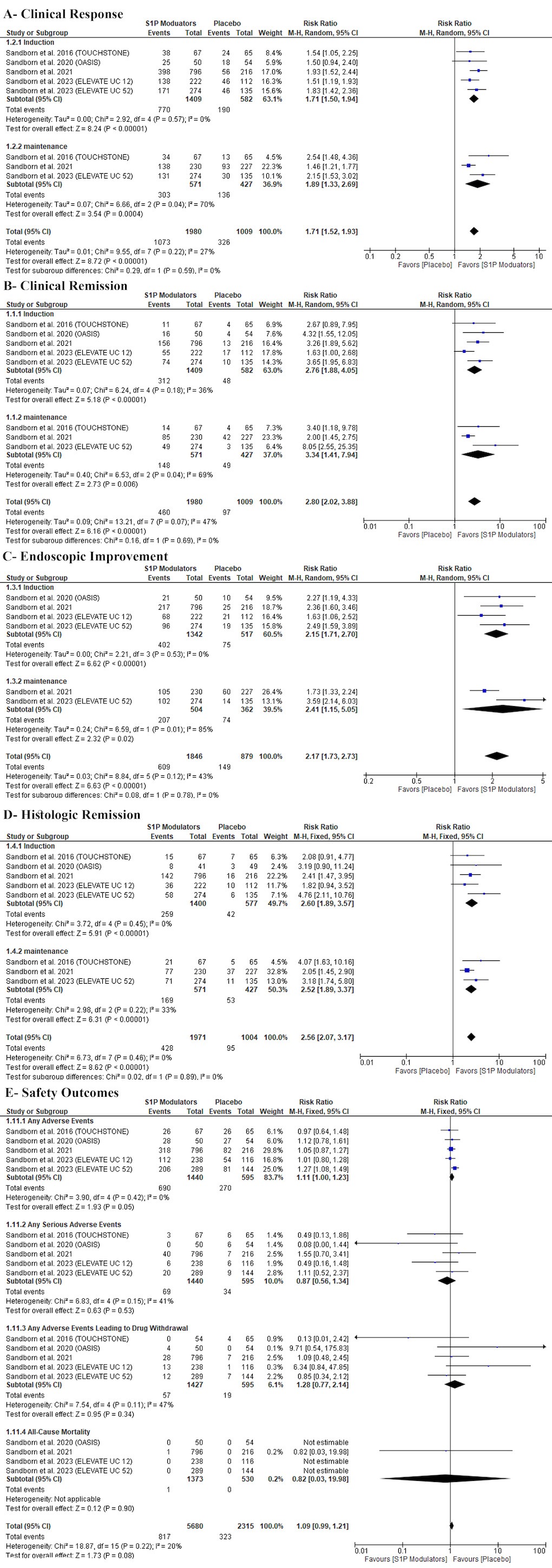Sunday Poster Session
Category: IBD
P0677 - Sphingosine 1-Phosphate Receptor Modulators as an Induction and Maintenance Therapy for Ulcerative Colitis: A Systematic Review and Meta-Analysis of Randomized Controlled Trials
Sunday, October 22, 2023
3:30 PM - 7:00 PM PT
Location: Exhibit Hall

Has Audio

Fouad Jaber, MD
University of Missouri-Kansas City
Kansas City, MO
Presenting Author(s)
Husam Abu Suilik, MD1, Mohamed Abuelazm, MBBCh2, Fouad Jaber, MD3, Mohamed A. Elzeftawy, MBBCh2, Amr Elrosasy, MD4, Alaa Ramadan, MBBCh5, Rana Ahmed Youssef, MBBCh6, Basel Abdelazeem, MD7
1Hashemite University, Amman, 'Amman, Jordan; 2Tanta University, Tanta, Al Gharbiyah, Egypt; 3University of Missouri Kansas City, Kansas City, MO; 4Cairo University, Cairo, Al Jizah, Egypt; 5South Valley University, Qena, Qina, Egypt; 6Alexandria University, Alexandria, Al Iskandariyah, Egypt; 7McLaren Health Care, Michigan State University, Flint, MI
Introduction: Sphingosine-1-phosphate (S1P) receptor modulators, including ozanimod and etrasimod, are currently under investigation for ulcerative colitis (UC) management. Therefore, we aim to evaluate the efficacy and safety of S1P modulators in patients with active UC during induction and maintenance periods.
Methods: We conducted a systematic review and meta-analysis synthesizing randomized controlled trials (RCTs), which were retrieved by systematically searching: PubMed, Web of Science, SCOPUS, and Cochrane through May 13th, 2023. We used the fixed-effect model to pool dichotomous data using risk ratio (RR) with a 95% confidence interval (CI).
Results: We included five RCTs with a total of 1,990 patients. S1P receptor modulators were significantly associated with increased clinical response during both induction (RR: 1.71 with 95% CI [1.50, 1.94], P= 0.00001) and maintenance phases (RR: 1.89 with 95% CI [1.33, 2.69], P= 0.0004); clinical remission rates during both induction (RR: 2.76 with 95% CI [1.88, 4.05], P= 0.00001) and maintenance phases (RR: 3.34 with 95% CI [1.41, 7.94], P= 0.006); endoscopic improvement during both induction (RR: 2.15 with 95% CI [1.71, 2.70], P= 0.00001) and maintenance phases (RR: 2.41 with 95% CI [1.15, 5.05], P= 0.02); histologic remission during both induction (RR: 2.60 with 95% CI [1.89, 3.57] [1.17, 2.10], P= 0.00001) and maintenance phases (RR: 2.52 with 95% CI [1.89, 3.37], P= 0.00001). Finally, there was no difference between etrolizumab and placebo regarding safety outcomes.
Discussion: S1P receptor modulators were effective as an induction and maintenance therapy for moderate to severe UC based on clinical, endoscopic, and histologic remission. Further research is therefore warranted to investigate the S1P receptor modulator’s position in UC management guidelines by head-to-head comparisons with other validated drugs, such as vedolizumab.

Disclosures:
Husam Abu Suilik, MD1, Mohamed Abuelazm, MBBCh2, Fouad Jaber, MD3, Mohamed A. Elzeftawy, MBBCh2, Amr Elrosasy, MD4, Alaa Ramadan, MBBCh5, Rana Ahmed Youssef, MBBCh6, Basel Abdelazeem, MD7. P0677 - Sphingosine 1-Phosphate Receptor Modulators as an Induction and Maintenance Therapy for Ulcerative Colitis: A Systematic Review and Meta-Analysis of Randomized Controlled Trials, ACG 2023 Annual Scientific Meeting Abstracts. Vancouver, BC, Canada: American College of Gastroenterology.
1Hashemite University, Amman, 'Amman, Jordan; 2Tanta University, Tanta, Al Gharbiyah, Egypt; 3University of Missouri Kansas City, Kansas City, MO; 4Cairo University, Cairo, Al Jizah, Egypt; 5South Valley University, Qena, Qina, Egypt; 6Alexandria University, Alexandria, Al Iskandariyah, Egypt; 7McLaren Health Care, Michigan State University, Flint, MI
Introduction: Sphingosine-1-phosphate (S1P) receptor modulators, including ozanimod and etrasimod, are currently under investigation for ulcerative colitis (UC) management. Therefore, we aim to evaluate the efficacy and safety of S1P modulators in patients with active UC during induction and maintenance periods.
Methods: We conducted a systematic review and meta-analysis synthesizing randomized controlled trials (RCTs), which were retrieved by systematically searching: PubMed, Web of Science, SCOPUS, and Cochrane through May 13th, 2023. We used the fixed-effect model to pool dichotomous data using risk ratio (RR) with a 95% confidence interval (CI).
Results: We included five RCTs with a total of 1,990 patients. S1P receptor modulators were significantly associated with increased clinical response during both induction (RR: 1.71 with 95% CI [1.50, 1.94], P= 0.00001) and maintenance phases (RR: 1.89 with 95% CI [1.33, 2.69], P= 0.0004); clinical remission rates during both induction (RR: 2.76 with 95% CI [1.88, 4.05], P= 0.00001) and maintenance phases (RR: 3.34 with 95% CI [1.41, 7.94], P= 0.006); endoscopic improvement during both induction (RR: 2.15 with 95% CI [1.71, 2.70], P= 0.00001) and maintenance phases (RR: 2.41 with 95% CI [1.15, 5.05], P= 0.02); histologic remission during both induction (RR: 2.60 with 95% CI [1.89, 3.57] [1.17, 2.10], P= 0.00001) and maintenance phases (RR: 2.52 with 95% CI [1.89, 3.37], P= 0.00001). Finally, there was no difference between etrolizumab and placebo regarding safety outcomes.
Discussion: S1P receptor modulators were effective as an induction and maintenance therapy for moderate to severe UC based on clinical, endoscopic, and histologic remission. Further research is therefore warranted to investigate the S1P receptor modulator’s position in UC management guidelines by head-to-head comparisons with other validated drugs, such as vedolizumab.

Figure: Forest Plots for meta-analyses about (A) Clinical Response (B) Clinical Remission (C) Endoscopic Improvement (D) Histologic Remission and (E) Safety outcomes of S1P receptor modulators in ulcerative colitis patients
Disclosures:
Husam Abu Suilik indicated no relevant financial relationships.
Mohamed Abuelazm indicated no relevant financial relationships.
Fouad Jaber indicated no relevant financial relationships.
Mohamed A. Elzeftawy indicated no relevant financial relationships.
Amr Elrosasy indicated no relevant financial relationships.
Alaa Ramadan indicated no relevant financial relationships.
Rana Ahmed Youssef indicated no relevant financial relationships.
Basel Abdelazeem indicated no relevant financial relationships.
Husam Abu Suilik, MD1, Mohamed Abuelazm, MBBCh2, Fouad Jaber, MD3, Mohamed A. Elzeftawy, MBBCh2, Amr Elrosasy, MD4, Alaa Ramadan, MBBCh5, Rana Ahmed Youssef, MBBCh6, Basel Abdelazeem, MD7. P0677 - Sphingosine 1-Phosphate Receptor Modulators as an Induction and Maintenance Therapy for Ulcerative Colitis: A Systematic Review and Meta-Analysis of Randomized Controlled Trials, ACG 2023 Annual Scientific Meeting Abstracts. Vancouver, BC, Canada: American College of Gastroenterology.
